Saturday, May 30, 2015
Pic(k) of the Week: Storm over Roan Plateau
A late afternoon storm passes over the Roan Plateau, between the towns of Rifle and Palisade, in western Colorado.
25 May 2015.
-----more-----
Saturday, May 23, 2015
Pic(k) of the Week: Beer & Cliffs
Now, this was how to enjoy a good beer.
First, there was a quarter-sized-hailing thunderstorm. Then, cool sunshine. The time seemed right for an IPA, at the Palisade Brewing Company, in its courtyard, with the Book Cliffs as dramatic backdrop.
Palisade, Colorado.
22 May 2015.
Off Belay IPA
This is our India Pale Ale standard. A light body that allows three American hop varieties to demand your attention — a three pronged hop profile with bitter, floral and citrus notes. Off Belay is a perfect introduction for a newcomer to the world of the IPA, as well as a gold standard for the hop enthusiast.
7% ABV
64 IBU
Centennial, Chinook, Simcoe
2-row pale, dextrin, crystal
"How long has the brewery been here," I asked the bartender. "Over nine years," she told me, "but back then, it was called the Palisade Brewery." "What's it called now, I asked." "Palisade Brewing Company." Uh, okay!
Palisade's population is 2,300. That Friday afternoon, maybe 2% of the entire town (plus two) was at the brewery and winery and distillery (and, ahem, dispensary). All along the same block. Most outdoors. All legal 'craft.'
-----more-----
Labels: "Mountain West", beer, beer review, brewpub, Colorado, nature, Pic(k) of the Week
Tuesday, May 19, 2015
'Craft' beer's pandemic of quality un-control?
An instructor at the Siebel Institute once told me that there were two types of breweries: ones that had had an infection and ones that would have an infection. As 'craft' breweries proliferate like blooms in spring, beers gone bad will proliferate like weeds on the lawn. It's an inevitability, simply by the sheer number of brewery openings.
How a brewery handles that instance is a sure measure of its integrity and competence. Hide it? Go public? Mouth platitudes like, "we brew the best beers," or recommit to quality control and laboratory procedures?
A Richmond, Virginia, brewery recently found a problem in a beer and destroyed it, and went Facebooky public about it.
Here are two more 'craft' breweries' whose beers recently have 'gone off', but, in response, have done the right thing. Three Stars Brewing is a brewery in Washington, D.C.
3 Stars Brewing Company is issuing a voluntary recall of their 750ml bottles of Pandemic Porter due to an unintentional development of flavors in the final product.
“We take great pride in all of our beers, and Pandemic is certainly one of our favorites. Once in bottles, this batch developed some unintended flavors. We do not find that that this batch lives up to the quality that you, our valued customers, deserve. While there is no risk of harm from consumption, we feel that this batch of bottles falls short of our standards.”
An accidental sour can do more harm than merely leaving a bad taste in your mouth. The bottle might explode. Here's how Intuition Ale Works, a brewery in Jacksonville, Florida, dealt with a lactobacillus-infection in a beer.
Intuition Ale Works is announcing a total recall of our 2015 Underdark barrel-aged stout. We have found through testing that the 2015 batch contains lactobacillus that is causing unwanted sour flavors to develop in the beer.
Lactobacillus is commonly used to deliberately sour beers like lambics, Flanders reds and other Belgian styles, and our staff has enjoyed tasting the way this year’s Underdark has developed. We traced it back to one of the older bourbon barrels that we used for the 2015 batch of Underdark.
However, we realize that a sour stout was not the intended style of this year’s Underdark, and it is not what you purchased. We are therefore offering a full refund to anyone who chooses to return their unopened 2015 bottles.
In the meantime, please store bottles of 2015 Underdark in a cool place before returning them. We are concerned that the beer will continue to ferment in the bottle which will cause excessive pressure and the bottles could potentially explode, especially if they are stored in a warm environment. Avoid transporting bottles of 2015 Underdark in your car if it will be left unattended in the heat for an extended period of time. To be extra cautious we recommend storing and transporting bottles in a box.
Paul Gatza, Director of the (U.S.) Brewers Association (BA) went all macho-tough at the recent Craft Brewers Conference on the topic of quality. He told the assembled brewers:
Many people in this room have spent a lot of time and dedicated a good portion of their lives to building this community that we have today. So, seriously, don’t [mess] it up.
This could easily be read as an attack by big 'craft' on small 'craft.' The former has the wherewithal to conduct extensive and expensive laboratory analyses. And big 'craft' breweries have more to lose if drinkers have bad experiences with beers from smaller breweries. A customer might broad brush all 'craft' as problematic.
Small breweries might not have the funds to build and staff state-of-the-art labs, but even small steps toward quality control are better than no steps. Gatza guessed at a 10% figure of 'craft' breweries as producing poor-quality beer of some sort. Ten percent of the U.S. total of 3,418 'craft' breweries is 341 breweries. That would be a lot of bad beer.
The BA is right on this aspect of the quality of beer: if a beer tastes bad, a brewery will lose customers. The proliferation of 'bad' beers —and, anecdotally, I have heard of not just a few examples— isn't just a numbers thing. There are 'craft' breweries who fail to be proactive.
I hear often: "Oh, yeah we'll build a lab at some point after we get open." That's parsimonious procrastination, and risky. Understanding the processes at work —and they are microbiological— is as much a part of "we make the best beers," as sweating over a mash tun. Mean what you say.
The three breweries, above, identified problems, and say they are investigating the reasons for them.
Otherwise, an accidental sour can be a dangerous thing.
-----more-----
Monday, May 18, 2015
Tale of three breweries: one open, two soon to be.
I celebrated American Craft Beer Week, in part, by visiting three American 'craft' breweries: one in Virginia, and just opened, and two in Maryland, soon to open.
Caboose Brewing (Virginia)
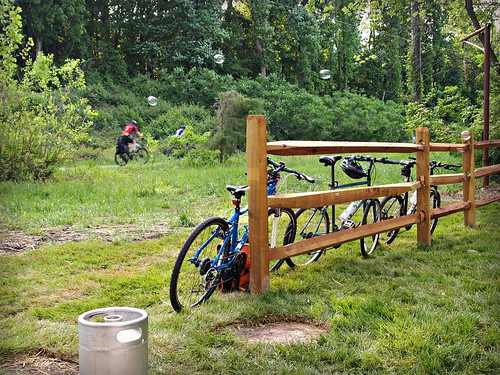
Caboose Brewing is a brewpub in Vienna, Virginia (a suburb of Washington, D.C.). After two years of construction, it officially opened last week. I visited on Friday afternoon. The W&OD bicycle trail is mere feet from the brewpub, and many bicycles, and their owners, were present.
Pictured is brewer Chris Mallon, looking proud. More photos: here.
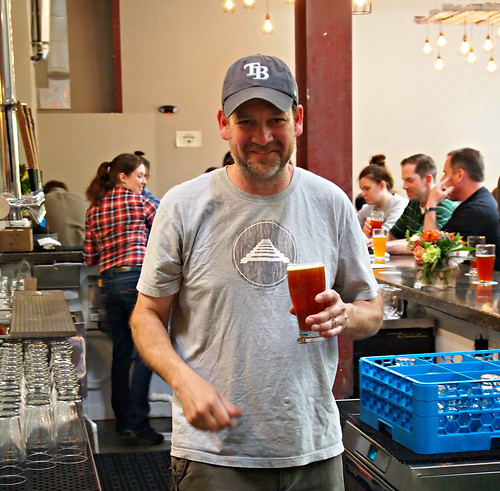
Oliver Brewing(Maryland)
Oliver Brewing is Maryland's oldest continuously operating brewery. Since 1993, it has been housed in the basement of the Pratt Street Alehouse (originally called the Wharf Rat) in downtown Baltimore. Its new production facility, in the Clifton Park neighborhood of Baltimore, has been under construction for about a year. Brewing commences there in June (and ceases in the brewpub). Pictured is the new 5-vessel 20-barrel brewhouse.
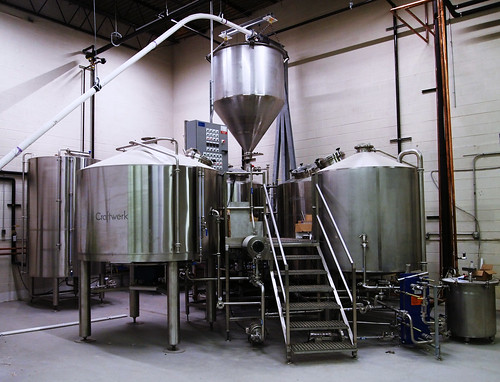
Key Brewing (Maryland)
Key Brewing has been a 5-year project of long-time Baltimore, Maryland, brewer Mike McDonald and restaurant-consultant Spike Owen. Now, the endgame (or more properly, the beginning!) is near. Located in Dundalk, Maryland (just outside of Baltimore), the new brewery should be operational this summer. Pictured is the 40-barrel brewhouse.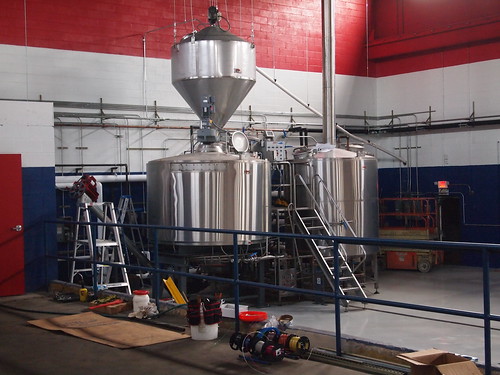
I talked with the principals of all three breweries. Those interviews, and more photos, to come.
-----more-----
Saturday, May 16, 2015
Monday, May 11, 2015
1976 - 2015: Celebrating American 'Craft' Beer, this week.
Today is the 70th birthday of Jack McAuliffe. Thirty-nine years ago, in 1976, McAuliffe opened New Albion Brewing, in Sonoma, California. It would be the nation's first-ever 'craft' brewery. 1
“In my opinion, Jack started the most important failed brewery,” said Maureen Ogle, a historian and author of Ambitious Brew: The Story of American Beer. “He demonstrated that the new brewing model could work and despite the fact that it didn’t last long and failed spectacularly, his influence played a significant role for the first successful batch of microbrewers.”
Thus it's fitting that today marks the first day of the 10th annual American Craft Beer Week, which runs through Sunday, 11-17 May, organized by the (U.S.) Brewers Association.
“American Craft Beer Week has provided independent beer fans across the country a chance to support their local breweries since 2006,” said Julia Herz, publisher of CraftBeer.com and craft beer program director at the Brewers Association. “With celebrations happening in all 50 states, this is truly an annual national event that recognizes all those involved in making craft beer from small breweries in the U.S. such a success.”
The Brewers Association defines a craft brewery as "small, independent, and traditional," 2 and these are heady times indeed for the non-profit advocacy group and its members. At the close of 2014, there were 3,418 'craft' breweries in the U.S., producing 22 million barrels of beer worth $19.6 billion dollars, accounting for 11% of all beer sold in the U.S.
In contrast to this U.S. beer-bunting, let's backtrack, and look to Great Britain, in 1933. That year, in the face of industrial unrest and poor declining beer sales (was that cause or effect?), its Brewers' Society launched a marketing campaign to highlight beer's benefit and social value to the nation.
The campaign had to raise the status of the product, so that it was important that "drawings of family groups should not depict a lower social order than that of a middle class family." The ads were signed off with the line, "Beer is Best". But surely the best posters, the ones that dais everything that ever needed to be said, were those that ran with a different three-word slogan of genius: "Beer. It's lovely!"Pete Brown. Man Walks into a Pub. 2004
A simple phrase, and, well, so lovely. So to the point. No patting-on-the-back selfie. Just the promise of beautiful bubbles at the end of the day. 3
But we have what we have. And it's American Craft Beer Week.4
Beginning on a Monday rather than a Sunday (European-like), it's a true seven-day week of celebration, unlike many of the city-only beer weeks that run, Ringo Starr-like, eight days a week, and often longer.
Choose this week to reflect upon the thirty-nine years of achievements of the 'craft beer' business since 1976: not for fomenting a beer revolution, but for the hard work, ingenuity, and, often, tasty results of the brewers, then and now.
Support the week by supporting an American 'craft brewery', however you may define it. Buy an American 'craft' beer.
-----more-----
Saturday, May 09, 2015
Pic(k) of the Week: Mint Julep under ice
This was the refreshing, cold-sweating, Mint Julep, served to me at Rhodeside Grill, a pub and restaurant in the Court House neighborhood of Arlington, Virginia, on Friday, 1 May 2015. It was the afternoon before the 141st running of the Kentucky Derby in Louisville, Kentucky.
The Mint Julep is the traditional drink of the Kentucky Derby, during which some 80,000 juleps are served. Traditionally, Mint Juleps are served in silver or pewter cups and held by the handle or rim in order for the cup to maintain optimum frost. Beyond the bourbon, sugar, and mint, the only other requirement for this drink is crushed ice. Any other form of ice will not create the same effect, so take the time to create a nice mound of crushed ice before mixing this cocktail. As an alternative to muddling the mint and sugar cube you can also infuse a sugar syrup with mint. With this much bourbon in a drink, slow sipping is the appropriate way to imbibe.— About.com
This Mint Julep was mixed for me by Paul Taylor, the long-time Beverage Director at the Vintage Restaurant Group —the umbrella-owner of Rhodeside Grill and three other northern Virginia restaurants. A mixologist iconoclast, Taylor dashed the bourbon with bitters. And it wasn't just any bourbon. It was Woodford Reserve. (This wasn't the first Mint Julep that Mr. Taylor had mixed for me. He did the same, a year earlier, also on the Friday before the Kentucky Derby. A tradition?)
Three days later, Taylor would move to Washington, D.C., for his new, similar, position at the bourbon-happy restaurant, Southern Efficiency.
A "Southern food and whiskey bar," Southern Efficiency is named after President John F. Kennedy's 1961 observation on the capital: "Washington is a city of Southern efficiency and Northern charm."
Need another reason for enjoying a Mint Julep? Here's a rhapsody to the drink, written by one Joshua Soule Smith, a Kentucky judge and journalist of the late 1800s.
-----more-----Then comes the zenith of man’s pleasure. Then comes the julep – the mint julep. Who has not tasted one has lived in vain. The honey of Hymettus brought no such solace to the soul; the nectar of the Gods is tame beside it. It is the very dream of drinks, the vision of sweet quaffings.
The Bourbon and the mint are lovers. In the same land they live, on the same food they are fostered. The mint dips infant leaf into the same stream that makes The Bourbon what it is. The corn grows in the level lands through which small streams meander. By the brook-side the mint grows. As the little wavelets pass, they glide up to kiss the feet of the growing mint, and the mint bends to salute them. Gracious and kind it is, living only for the sake of others. Like a woman’s heart it gives its sweetest aroma when bruised. Among the first to greet the spring, it comes. Beside gurgling brooks that make music in the fields, it lives and thrives. When the bluegrass begins to shoot its gentle sprays towards the sun, mint comes, and its sweetest soul drinks at the crystal brook. It is virgin then. But soon it must be married to old Bourbon. His great heart, his warmth of temperament, and that affinity which no one understands, demands the wedding.
How shall it be? Take from the cold spring some water, pure as angels are; mix it with sugar till it seems like oil. Then take a glass and crush your mint within it with a spoon – crush it around the borders of the glass and leave no place untouched. Then throw the mint away – it is the sacrifice. Fill with cracked ice the glass; pour in the quantity of Bourbon which you want. It trickles slowly through the ice. Let it have time to cool, then pour your sugared water over it. No spoon is needed; no stirring allowed- just let it stand a moment. Then around the brim place sprigs of mint, so that the one who drinks may find the taste and odor at one draft.
Then when it is made, sip it slowly. August suns are shining, the breath of the south wind is upon you. It is fragrant cold and sweet – it is seductive. No maidens kiss is tenderer or more refreshing, no maidens touch could be more passionate. Sip it and dream-it is a dream itself. No other land can give you so much sweet solace for your cares; no other liquor soothes you in melancholy days. Sip it and say there is no solace for the soul, no tonic for the body like old Bourbon whiskey.
Friday, May 08, 2015
Spring Real Ale Festival in Baltimore, Maryland.
Our friends at Pratt Street Ale House,in Baltimore, Maryland, are hosting their Spring Real Festival, this Saturday.
They're pouring thirty-two cask-conditioned ales and one cask-conditioned lager. Nineteen come from breweries in Maryland; two from Washington, D.C.; two from Pennsylvania; two from Colorado; one from New Jersey; one from Georgia; and five from breweries in the United Kingdom. This is a bookend to their Chesapeake Real Ale Fest, held every October.
Pratt Street has been the home of Oliver Brewing since 1993 (when the pub was originally known as the Wharf Rat). The brewery creates (among other styles) British-style ales, poured cask-conditioned, via hand-pumps, at the pub.
I asked brewmaster Steve Jones (himself an ex-pat Briton), the host and organizer, about the difficulties (and pleasures) of running a cask ale festival.
Hosting a cask ale festival at a brewpub presents numerous challenges. Ideally, a cask-conditioned beer is set in the place from which it is to be served, at cellar temperature, for several days prior to being vented/tapped, to allow the yeast to settle, allowing the beer to be served at optimal clarity and condition. The casks are soft-spiled for the necessary amount of time to allow the venting of excess carbon dioxide (condition).
This is obviously not possible in a festival environment, such as this.
Casks are stored at regular cold room temperature (40 °F), as we don't have sufficient storage space in our cask (52 °F) room. I vent the casks 24-36 hours prior to the festival, and soft-spile them. Because of the colder temperature, we can't expect them to attain ideal conditioning (CO2 being more soluble at lower temperatures).
Casks are carefully moved to their serving stations during the early morning of the day of the festival (efforts being made to disturb the beer as little as possible). This allows them the opportunity to slowly warm up to cellar temperature (52 °F) over the course of the three or so hours before the start of the festival. Excess condition will be vented off to some degree at this time. Casks are also tapped at this point.
During the festival, casks are kept cool by using bar towels soaked in ice water draped over the cask. Evaporation of the water from the towels will serve to cool the casks; the bar towels are frequently replaced, as they warm and dry out.
Whereas Jones' draft beers are transferred to a conditioning tank, all of his casks are filled directly from the brewery's open fermenting vessels post-fermentation, and are 'primed' with a bit of fermenting wort and fined with isinglass.
Saturday's outdoor festival could be considered a celebration of another event, as well.
After 23 years, the small 'Peter Austin' brew-kit in the basement of the the pub —which Jones often refers to as a Hobbit brewery— is about to be decommissioned. Oliver Brewing Company has nearly completed construction on a much larger production-only facility, offsite, in eastern Baltimore. The Pratt Street Pub will reamain where it is, in downtown Baltimore, across from the Convention Center and Oriole Park at Camden Yards.
For the Festival, Jones is serving five of his own cask-conditioned ales, including two that he brewed in collaboration with local breweries for American Mild Month.
- Burial At Sea
Ruby mild. 3% alcohol-by-volume (abv).
Brewed in collaboration with DC Brau (Washington, D.C.) for American Mild Month. - Cherry Blossom Ale
Wheat ale fermented with dark sweet cherry puree. 5.8% abv.
- Dark Horse
Dark mild ale. 3.8% abv.
- Olde Fashion Black Magik
Dark ale. Brewed on the occasion of the recent 22nd anniversary of Oliver Brewing. 9.4% abv.
Steve Jones' comment: "Olde Fashion Black Magik has been conditioned in a 10-gallon toasted American oak barrel, from which it will be drawn via beer engine. This barrel has been much used, so we won't know what effect it will have on the beer until we tap it, on Saturday morning." - Straight On 'Til Morning
Golden-oat mild. 3% abv.
Brewed in collaboration with DuClaw Brewing (Rosedale, Maryland) for American Mild Month.
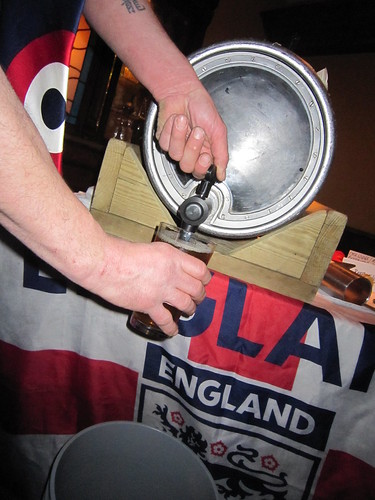
The festival runs from 1 until 5pm. Admittance allows for unlimited sampling (within the bounds of propriety!). Very Important Persons can gain an extra hour of festiveness, at noon. (This exclusivity is gained by paying a somewhat higher ticket cost.) Food is available in the pub.
An ardent traditionalist, Jones finished by affirming:
I hasten to add that none of my casks have any "additions" other than finings!
Here's the rest of the afternoon's line-up.
- The Brewer's Art (Baltimore, Maryland)
- Birdhouse, with grapefruit and Amarillo hops.
- Charm City Sour Cherry Ale.
- Burley Oak Brewing (Berlin, Maryland)
to be determined. - Coniston Brewery (U.K.)
Bluebird Bitter.
Supreme Champion Beer of Britain: Great British Beer Festival, 1998. - Dark Star Brewery (U.K.)
Revelation English Ale, brewed with American hops. - DC Brau (Washington, D.C.)
- On The Wings Of Armageddon Imperial IPA, with grapefruit.
- El Hefe Hefeweizen.
- DuClaw Brewing (Rosedale, Maryland)
- Anti-Venom, double dry-hopped.
- Mosaic Red, double dry hopped (hop continuum #2).
- Flying Dog Brewery (Frederick, Maryland)
Single Hop Warrior. - Flying Fish Brewery (Somerdale, New Jersey)
to be determined. - Heavy Seas Beer (Halethorpe, Maryland)
Deep Six Porter. - Hobsons Brewery (U.K.)
Manor Ale ESB. - Ilkley Brewery (U.K.)
- Mary Jane IPA.
- The Mayan Chocolate Chipotle Stout.
- Jailbreak Brewing (Laurel, Maryland)
Welcome to Scoville Jalapeno IPA w/ blue corn tortillas, mango, and cherry red and long hot peppers. - Manor Hill Brewing
- IPA, with azacca, passion fruit, and raw organic cocoa nibs.
- 4 Grain Saison, with Hallertau Blanc hops, grapefruit juice, grapefruit peel, and fresh lemongrass.
- Monocacy Brewing (Frederick, Maryland)
Riot Rye Pale Ale, with mango. - Monument City Brewing (Baltimore, Maryland)
51 Rye IPA. - New Belgium Brewing (Fort Collins, Colorado)
- Portage Porter, dry hopped with Willamette hops.
- Skinny Dip citrus-infused lager.
- The Raven Brewery (Baltimore, Maryland)
Annabel Lee Belgian-style Wit, dry-hopped with Citra Hops. - Sly Fox Beer (Phoenixville, Pennsylvania)
O’Reilly’s Stout. - Terrapin Beer (Athens, Georgia)
Single Hop Imperial IPA, with Ella hops. - Union Craft Brewing (Baltimore, Maryland)
to be determined. - Weyerbacher Brewing (Easton, Pennsylvania)
to be determined. - Yards Brewing (Philadelphia, Pennsylvania)
Philly Pale Ale, with grapefruit.
- Admission is $40 for admission at 1pm (including 'unlimited' tasting) or $60 for 'VIP' admission at noon. Available: here.
- Isinglass is a traditional fining agent (clarifier) for cask ales. Pulverized, it electro-chemically attracts yeast and proteins, and falls, clumped together, to the bottom of a cask, clarifying the ale. Derived from the swim bladders of fish, isinglass will not be in the finished beer, if used properly, but below the level of the serving tap.
- Caveat lector: As a representative for Select Wines, Inc. —a wine and beer wholesaler in northern Virginia— I sell the beers of Oliver Brewing. Any opinions here are mine alone.
- For more from YFGF:
- Follow on Twitter: @Cizauskas.
- Like on Facebook: YoursForGoodFermentables.
- Follow on Flickr: Cizauskas.
Wednesday, May 06, 2015
More 'craft' lagers, please!
On the second day of American Mild Month, last Saturday, what did I do? I went to a Spring Bock Festival, held outdoors at Mad Fox Brewing Company, a brewpub in Falls Church, Virginia (a town only a few miles outside of Washington, D.C.).
What is bock?
Bock beer might not be the antithesis of Mild Ale, but it's certainly not similar. Mild Ale is, of course, an ale, and of low alcohol. Bock is a lager, and high in alcohol.But, oh, what splendid things well-made bocks can be! Dark red-brown (not stout-black), rich, alcohol-warming, malt-luscious, and anywhere from 6 to 7% alcohol-by-volume; and, in the case of maibocks (or 'heller bocks'): deep golden-malty, drier than a 'standard' bock, and noble-hoppy.
Doppelbocks are stronger yet, by convention, over 7% alcohol-by-volume, dark brown-red and (not cloyingly) malty-sweet, but some examples can reach 13%.
More 'craft' bocks?
Attending the festival were thirty-six breweries bringing seventy-two beers. Of those beers, twenty-two were bock beers. It's refreshing (pun intended) to find more 'craft' breweries brewing lagers in this age of hyper-hoppy ales.All but one of these breweries were from the local area: twenty-four were from Virginia, five from Maryland, two from Washington, D.C., three from Pennsylvania, and one from Delaware. The outlier was from Bavaria, in Germany: no personal representative, but two bock biers.
Smoked bock?
Three of the local bocks were made with reasonable percentages of smoked malt. This didn't smack so much of stylistic misinterpretation —such as the assumption by many 'craft brewers' that Scotch Ales must be, ipso facto, peat-smoked— but, rather, as part and parcel of the American 'craft' need to tinker. A 'new' sub-genre?
Cask-conditioned bock?
One bock that afternoon was served cask-conditioned. I wondered, "Why?"Cask-conditioning an ale can bring an unfettered freshness and clarity of flavor to an ale. (Not all ales benefit, however, and that's a story for another time.) Cask-conditioning a lager, such as a bock, on the other hand, does it few favors.
When a properly lagered beer is re-primed with fresh lager yeast in a cask, off-flavors such as sulfur, green apple, and butteriness —that lagering (extended cold storage) had lessened or removed— are reintroduced into the beer. Of course, an ale yeast could be used for priming, instead of a lager yeast. Created then is some sort of hybrid mess, confusing the flavor and nature of the beer.
A much better practice is racking (transferring) already-carbonated lager straight from a maturation tank into a keg. This is called kellerbier or zwickelbier. And if that lager were racked instead into a cask and served? It still wouldn't be a cask-conditioned lager, but simply a lager served from a cask.
The ill-suited cask-conditioned bock in question had also been infused with peppers, cinnamon, and cloves. Again, why? This will not be, I hope, a new sub-genre.
A good day for bock
Bill Madden, president/brewmaster of Mad Fox, has been organizing beer festivals since the mid-1990s, when he was the executive brewer for another area brewpub, Capitol City Brewing. That experience showed.
Brewers and brewery representatives were present. Brewery tables were organized alphabetically, making beers easy to locate. And all with the cooperation of the weather: 79 °F, under mostly sunny skies, with a mild (there you go!) breeze. Seamless enjoyment.
More 'craft' lagers, please!
-----more-----
Tuesday, May 05, 2015
Tempest in a Craft Beer Week
If you doubted that 'craft beer's' singing of kumbaya-around-the-brew-kettle might be ending, look here.
In an interview in a Madison, Wisconsin, periodical, an organizer of the Madison Craft Beer Week (MCBW) seemingly took a passive-aggressive swipe against two mainstays of 'craft beer' in the city: the Great Dane Brewpub (founded 1994) and Capital Brewery (founded 1986, in nearby Middleton).
Q:
How has the Madison craft beer scene changed since you got here in 2006?
A:
It has grown immensely. There’s a lot more players in the market. It has gone from being a fairly standard beer oriented market to a very adventurous beer market. When I first got here it was Great Dane and Capital and that was about it.
(And) it was still all relatively normal beers. They had their ambers and their porters and their pale ales and their pilsners, there wasn’t anything really weird or exciting or creative particularly about it. It was all good, it wasn’t bad, but it just wasn’t that interesting either.
I think that has changed significantly with the influx of nanobreweries like One Barrel, with super creative brewers like Scott Manning at Vintage or Aran Madden at Furthermore or Andrew (Gierczak) and Henry (Schwartz) over at MobCraft. You have breweries in the market now that are doing such strange and creative things with beer that simply didn’t exist in 2006 when I moved here.
To which, Great Dane took umbrage:
Unfortunately, for the second year in a row, an organizer of MCBW has chosen to speak publicly in a way that is demeaning to some of the breweries who work to make their event a success. While the slight in both instances were most likely unintentional, they both speak to the same unsettling trend in America’s craft beer movement, where breweries whose “raison d’être” is to only make extreme beers, are shown more appreciation than those who take a more even-keeled approach.
Even if this attitude reflected the opinion of the majority of beer drinkers, which it probably doesn’t, given the immense popularity of beers such as Spotted Cow, it certainly isn’t accurate in regards to the Great Dane or Capital Brewery. The Great Dane has consistently offered many specialty beers over the years that have been either very hoppy or utilized unique and interesting ingredients. We were the first in Wisconsin to offer a cask ale program, as well as the first in the nation to offer a non-stout nitro beer on tap (our Devil’s Lake Red Lager). Kirby Nelson’s Autumnal Fire was far from boring, even though it didn’t have any “weird” ingredients.
The Great American Beer Festival, which named The Great Dane as 2012’s “Best American Brewpub Group,” and Rob LoBreglio “America’s Best Brewpub Group Brewer,” and which has awarded The Great Dane dozens of medals over the years, does not have the same one-sided view of the brewing industry. It is similar to the difference between those who prefer the X-Games versus those who prefer the Olympics. It is nice that Madisonians can attend a tap takeover where most of the beers are from out-of-state breweries and 100+ IBUs. Just as we have been doing for over 20 years, we’ll be here for those who appreciate the traditional AS WELL AS the innovative.
Great Dane may have been a bit snippy in its retort, but its point, well taken. Is not the act of creating good beer itself creative? Why demean, even if gently, when the point of a celebration of a city's beer culture is to celebrate the good totality of it? Was this all taken out of context? The MCBW may yet respond to the response.
And then there's a bigger question.
When the term 'craft beer' can encompass everything from extremely hoppy beers to well-etched pilsners, brewed by breweries of one-barrel, so-called, nano-brewery-size to 6-million barrel annual production regional-brewery-size, is the term a thing lacking relevance except for purposes of Linnaean-like taxonomy, marketing, association, political lobbying, and dues? *
If we accept 'craft beer' as real or Platonic ideal (I don't, which is why I enclose it in single quotations), what is it, then? Is it simply beer which is innovative, as I was recently 'schooled' on Twitter? Or would it be beer that is fresh, flavorful, well-made, and enjoyable, as well as beer of —but not limited to— variety and experimentation? (Small and local being plusses, if not end-alls.) Way too many modifiers to neatly fit into any definition.
Putting this in perspective was Kirby Nelson, brewmaster of Capital Brewery, who responded succinctly (if not in an official capacity) on Facebook:
Here's to the appreciation of all great beer,
from the mild to the extreme.
As this May is the first-ever American Mild Month, I'd agree with that.
-----more-----
Monday, May 04, 2015
Clamps & Gaskets: News Roundup for Weeks 16/17, 2015.

A bi-weekly, non-comprehensive roundup
of news of beer and other things.
Weeks 16/17
12 April - 25 April 2015
- 2015.04.25
A magnitude 7.8 earthquake has struck Nepal: "hundreds dead, history crumbled, Everest shaken."
—Via AP at Yahoo News.
UPDATE 1 May 2015
"The true extent of the damage from the magnitude-7.8 earthquake is still unknown as reports keep filtering in from remote areas, some of which remain entirely cut off. The U.N. has estimated the quake affected 8.1 million people — more than a quarter of Nepal's 28 million people."
—Via AP (at Huffington Post). - 2015.04.23
"The need for brewers has vastly outstripped the available supply of those who actually know what they are doing."
—Via Dr. Michael J. Lewis, Professor Emeritus, Brewing Science at University of California, Davis (at Davis Enterprise). - 2015.04.23
The (U.S.) Brewers Association selects Matt Stinchfield (owner of Ploughshare Brewing Company in Lincoln, Nebraska) as its first 'safety ambassador': to promote safety in U.S. breweries.
—Via Brewers Association. - 2015.04.23
After weeks-long delay, the U.S. Senate confirms Loretta Lynch as U.S. Attorney General, the first African-American woman in that position.
—Via AFP (at Yahoo News). - 2015.04.23
Bubbles and buzz. 'Nitro' coffee, a new thing? “It’s a paradigm shift as far as what coffee can become.”
—Via WTOP Radio. - 2015.04.22
“Craft brewing is sucking up every pound of hops in the U.S. Growers can’t expand fast enough.”
—Via Popular Science. - 2015.04.22
Earth Day 2015.
—Via YFGF. - 2015.04.21
Strip clubs, sexism, and 'craft' beer.
—Via Jeff Alworth (at Beervana).
—Via Heather Vandenengel. - 2015.04.21
Five 'farmhouse breweries' operate in Maryland; that number may soon double.
—Via Fortune. - 2015.04.20
The Telegraph calls Melissa Cole: “The woman 'taking the beard out of beer.'”
—Via Telegraph. - 2015.04.20
“The passion has been professionalized.” Investors and bankers attracted to large 'craft' breweries.
—Via Market Watch. - 2015.04.19
Wineries have long been fermenting some of their their wine in concrete 'eggs.' Now, Hair of the Dog Brewing, in Portland, Oregon, may be the first American brewery to ferment its beer so.
—Via Brooston Beer Bulletin. - 2015.04.19
The Craft Brewers Conference: the state of the 'craft' beer industry in 2015. There are 3,418 'craft' breweries in the United States, and other statistics.
—Via YFGF. - 2015.04.16
The Food and Drug Administration (FDA) to mandate beer calorie information on chain-restaurant menus. Regulation may hurt smaller breweries.
—Via Craft Brewing Business. - 2015.04.14
Iowa governor signs bill into law, which states that, “'Beer' means beer.'”
—Via Brewers Association. - 2015.04.14
Percy Sledge, singer of the classic soul song, "When A Man Loves A Woman," has died at 74.
—Via Associated Press. - 2015.04.13
Dick Cantwell, co-founder of Elysian Brewing, to resign management position over disagreement with partners over sale of Washington state 'craft' brewery to Anheuser-Busch.
—Via Brewbound. - 2015.04.13
April 13, 2015 is the sesquicentennial of the assassination of President Abraham Lincoln (13 April 1865).
—Via Washington Post. - 2015.04.13
Günter Grass, German Nobel laureate, dies at 87. "Known around the world as the moral conscience of 20th-century Germany, a reputation that faltered when he belatedly revealed that he had served as a young soldier in Hitler’s SS."
—Via Washington Post.
Saturday, May 02, 2015
Pic(k) of the Week: Stillpoint hopyards wait for hops.
At the end of April, the acre of hopyards at Stillpoint Farm, in Mt. Airy, Maryland, were still 'un-bined' by hops. * That won't be for long.
When Carol McConaughy and Tom Barse first planted their hops only a few years ago, Stillpoint Farm became the first commercial hop farm to operate in Maryland since the 1870s. There are now several small-scale hop farms in Maryland.
In addition to hops, Stillpoint Farm raises sheep and horses, keeps bees and makes honey, and produces ... beer.
In 2012, the Milkhouse Brewery, then under construction on the farm, was the first brewery in Maryland to be granted a farm-brewery license. This 'Class 8' license allows a brewery (normally considered industrial) to operate on rural land and have a public taproom. The brewery must use ingredients grown on the farm (the amount or percentage not stipulated). The Milkhouse Brewery, of course, uses Stillpoint Farm hops: Cascades.
Mt. Airy, Maryland.
26 April 2015.
-----more-----
Friday, May 01, 2015
The audacity of Mild!
 The Session is a monthly event for the beer blogging community, begun in March of 2007 by Stan Hieronymus of Appellation Beer and Jay Brooks of the Brookston Beer Bulletin.
The Session is a monthly event for the beer blogging community, begun in March of 2007 by Stan Hieronymus of Appellation Beer and Jay Brooks of the Brookston Beer Bulletin.
On the first Friday of every month, a pre-determined beer blogger hosts The Session: Beer Blogging Friday. He or she chooses a specific, beer-related topic, invites all bloggers to write on it, and posts a roundup of all the responses received. For more information, view the archive page.
For May 2015, Alistair Reece —at the blog Fuggled— is the host of the 99th iteration of The Session. He also is the organizer of the first ever American Mild Month, celebrated this month, across the U.S. His topic is "Localising Mild."
This May is the first, as far as I am aware, American Mild Month, which has 45 breweries, so far, committed to brewing mild ales. Of those 45 breweries some are brewing the traditional English dark and pale mild styles, while a couple have said they will brew an 'American Mild', which American Mild Month describes as:
a restrained, darkish ale, with gentle hopping and a clean finish,
so that the malt and what hops are present shine through.
An essential element of the American Mild is that it uses American malts, hops, and the clean yeast strain that is commonly used over here. Like the development of many a beers style around the world, American Mild is the localisation of a beer from elsewhere, giving a nod to the original, but going its own way.
That then is the crux of the theme for The Session in May, how would you localise mild? What would an Irish, Belgian, Czech, or Australian Mild look like?
***************
First thing first. What exactly is a Mild Ale?
Historical Mild
Originally, the main, indeed the only standard for a beer called mild was that it should be fresh, not more than a couple of weeks old, and have the taste and aroma that come with freshness. Any older, past the point at which the beer starts exhibiting the flavours that come with maturity, and it isn't mild anymore, at least not what brewers would have recognized as mild back in the nineteenth and early twentieth centuries. [...]— Martyn Cornell. Amber, Gold & Black. 2010
All the other characteristics generally associated with mild today are secondary to the fact that it was meant to be delivered into the pub soon after it was brewed (just four to ten days after being casked [emphasis mine], against maturation periods of twenty-one days or more for the lighter draught pale ales).
According to British beer historians Martyn Cornell and Ron Pattinson, milds of a hundred and more years ago tended to be sweet, but, then again, could also be highly hopped and/or very strong.
The trend toward darker milds, as we know them today, began in the late 19th and early 20th centuries. The decrease in alcohol began in the early 20th century, and accelerated rapidly, for reasons such as tax laws and wartime restrictions.
The ur-characteristic of Mild Ale, in almost all of its permutations, was fresh, young beer.
Modern Mild
Today, the standard for Mild Ale might be as defined by the Campaign for Real Ale (CAMRA), in the U.K.Milds are black to dark brown to pale amber in colour and come in a variety of styles from warming roasty ales to light refreshing lunchtime thirst quenchers. Malty and possibly sweet tones dominate the flavour profile but there may be a light hop flavour or aroma. Slight diacetyl (toffee/butterscotch) flavours are not inappropriate. Alcohol levels are typically low.
Original gravity: less than 1043. Typical alcohol by volume: less than 4.3%. Bitterness 14 - 28 EBU.
- Pale milds tend to have a lighter, more fruity aroma with gentle hoppiness.
- Dark milds may have a light roast malt or caramel character in aroma and taste.
- Scottish cask beers may have mild characteristics with a dominance of sweetness, smooth body and light bitterness.
Compare that to these specifications from American Mild Month:
American Mild Ale should have an alcohol-content-by-volume (abv) of 4.5% or less, a color greater than 17 SRM (i.e., darker than a golden ale), and an International Bittering Unit (IBU) level of 30 or less (thus stronger than an English Mild, but 'milder' than an American IPA). One major departure from the English mild style in a theoretical American mild is the yeast. The classic American yeast strain used by many an American craft brewery is known for being very clean, allowing the other ingredients to shine through without contributing the fruity flavors of the British yeasts.
Tasting Mild
Let's skip the zymurgy, and go straight to gustation.Mild Ales are not intemperate. They are not harsh, severe, sharp, spicy, or bitter.
Mild Ales are pleasant comrades. They are low enough in alcohol so that two can be enjoyed in sobriety; they are mild enough to disdain extreme flavors, again so that two can be enjoyed without satiation; they are flavorful enough so that the triad of ale flavor —hops, yeast and malt, and especially the last— can be easily discerned by a drinker with pleasure and without 'expert' pretense. Dark? Maybe. Fruity? A tad. Hoppy? In the background.
And I'll call out those beer drinkers who say Mild Ales have no more-ishness. Stand up! WakeUp! Be audacious! Use your taste buds like a man (or woman). * Hopped-up hop-juicers are not the only beers of good character. Mild Ales might be mild-mannered, but they do not lack sinew, even if hidden. They are quintessential 'session' beers.
Localizing Mild
Mr. Reece hosted this "The Session: Beer Blogging Friday" by asking us to discuss "localizing milds." (My apology. I've American-ized his spelling).My response derives from the very description of Mild Ale itself. Historically and in present times, Mild Ales have been young, fresh ales. Just as a chef wouldn't (or couldn't) package the aromas of just-cooked food, a brewer wouldn't (or shouldn't) destroy the evanescence of her Mild Ale by shipping it far afield, over days or week. Youth ages and freshness stales. Mild Ale is, indeed, quintessentially local ale. Drink it close to the source.
Mild Afterthoughts
Like porter before it, Mild Ale has been a disappearing drink in the U.K. And, here in the U.S., it's a notch above nil.The name itself might be an impediment. Mild? What's that? Weak beer? A local brewer told me of the time, a decade ago, his Mild Ale was not selling well at the brewpub. He put the beer on the 'stout gas' line and renamed it "Nitro Monkey." It became a hit.
Almost 60 breweries, out of 3,400, in the nation are participating in this inaugural celebration. You might find it difficult to find an American Mild Ale. But ...
A friend returned from the recent Craft Brewers Conference in Portland with three observations. More female participation; more beards on men; more lower-alcohol beers. I'll take categories one and three for $500, Alex!
... The time might be ripe for a Mild Ale bump. After all, this is only year one for Mild Ale Month, and the celebration's organizer — Alistair Reece of Fuggled— is already plotting for next year, with some big names on board. And what can you do? Politely challenge your local brewery and local brewpub to brew a Mild Ale. The craft brewery movement should be community up, not conglomerate down.
Partake in the audacity of mild this May. Make it a Mild Ale.
-----more-----"You must have seen great changes since you were a young man," said Winston tentatively. The old man's pale blue eyes moved from the darts board to the bar, and from the bar to the door of the Gents ... "The beer was better," he said finally. "And cheaper! When I was a young man, MILD beer —wallop we used to call it — was four-pence a pint. That was before the war, of course." "Which war was that? said Winston. "It's all wars,' said the old man vaguely. He took up his glass, and his shoulders straightened again. "Ere's wishing you the very best of 'ealth!"— George Orwell. Nineteen Eighty-Four.

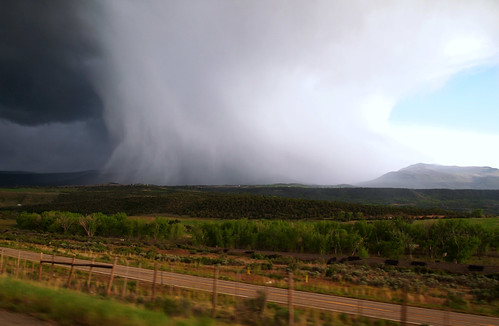



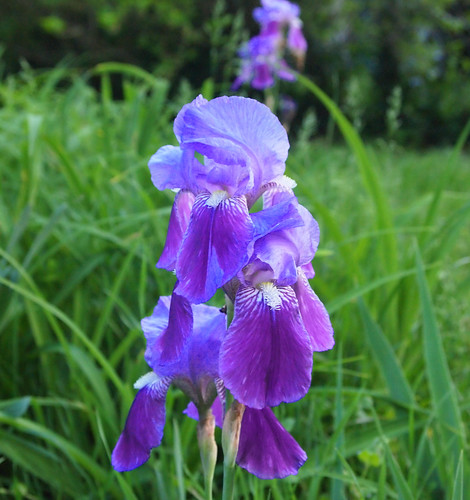
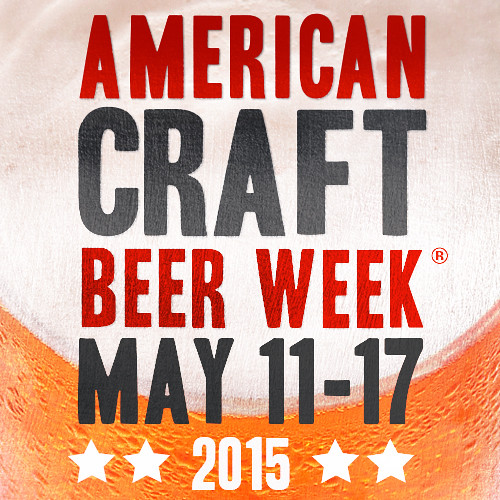



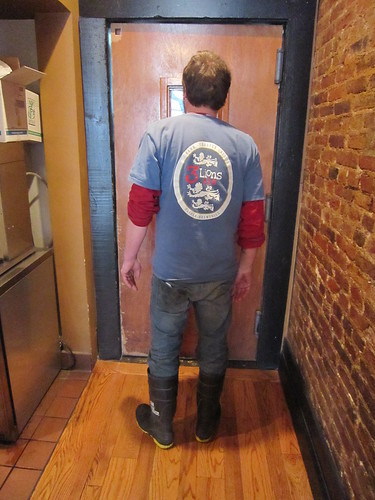

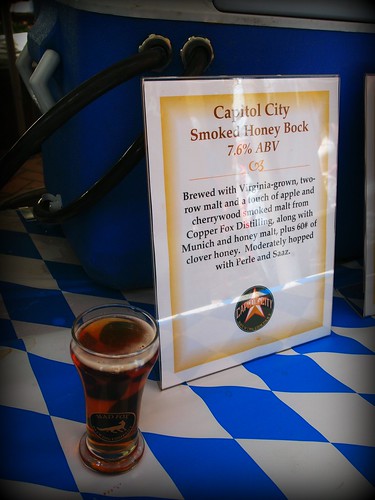


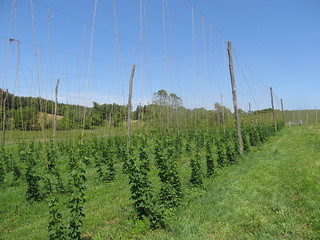

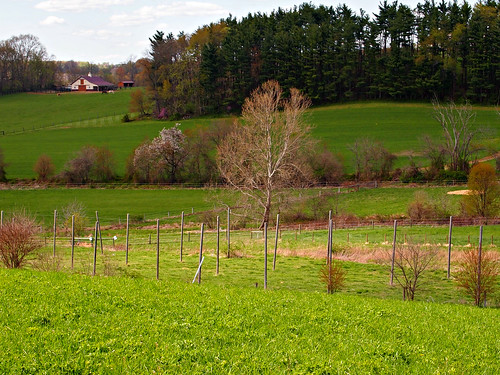


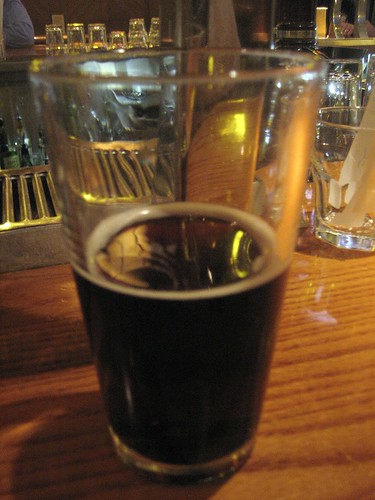



.png)





